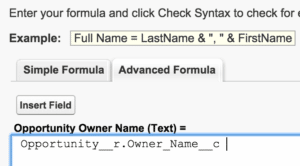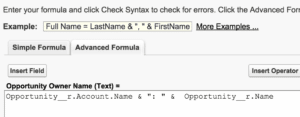Salesforce’s email template builder is pretty easy to use…that is until you try to pull in information from related objects.
In a recent situation, I was building an email template for a client who wanted very specific information to be pulled into the email. The object that the email template was being launched from was a custom object called “Activity Process.” The Activity Process record was also related to the Opportunity through a lookup field, and our client wanted information from both the Opportunity and the Activity Process to be included in the email template. Since the email template was being launched from the Activity Process, pulling in those merge fields was easy to do: First, I set the “Field Type” to Activity Process. Then, after selecting which fields I wanted, I copied and pasted them into the template.
Getting the correct merge fields from the related Opportunity, however, proved less easy. I changed my “Field Type” to Opportunity and selected my Opportunity field (which was “Owner Full Name”), then copied that merge field into my email template:

The problem is that when I ran a test to verify that my merge fields worked, the information that should have been coming from my Opportunity wasn’t getting pulled in at all. I saw two fairly simple workarounds for this limitation with Salesforce’s email template builder:
Conga Composer
Conga Composer creates excellent email templates that are extremely easy to use. After you create a new report with your needed Opportunity fields and add that report to your button URL, you can use template builder to copy and paste your needed merge fields into your email template. Then you can reference your Conga email template ID for your email template. This is the easiest workaround; however, there are times when you can’t use Conga for your email template and you MUST use Salesforce’s email template builder. An example of this would be the situation I described above–creating a custom email template for an Approval Process.
Which leads us to solution/workaround #2…
New Formula Fields
Since Conga wasn’t going to work for the particular email template I was working on, I decided that my solution would be creating new formula fields on my custom object. Here’s what I did:
The first field I built was for the Opportunity Owner name:

The second field I created was the related Account name with the Opportunity name:

Adding those two new fields into my template in Salesforce’s email template builder did the trick. Now, the right information is being pulled, and our client is generating email blasts that look good and serve their business.
I hope these tips help you get the most out Salesforce’s email template builder. What about your own experience using the tool–have you had to figure out a workaround or two when creating email templates? Leave a comment below and tell us all about it!






